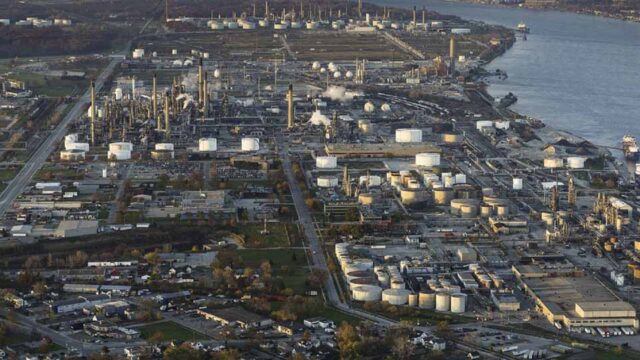This week, a coalition of environmental and health groups, led by the Canadian Environmental Law Association (CELA), sent a letter to Ontario Minister of the Environment and Climate Change Glen Murray urging him to protect the health of people in Ontario communities exposed to disproportionately high levels of industrial air pollution.
While Ecojustice doesn’t often sign onto group letters, we decided to sign this one. Here’s why.
People living in industry-heavy areas of cities such as Hamilton, Sarnia, and Windsor bear an unfair burden when it comes to exposure to air contaminants. Many of these substances — including benzene, sulphur dioxide, nitrogen oxides, polycyclic aromatic hydrocarbons, and particulate matter — are known to pose serious threats to human health. These include reproductive, cardiovascular, and developmental health risks, hormone disruption and cancer. Studies also show that children are particularly vulnerable to many of these heath threats.
Despite the fact that these health risks compound exponentially in communities that host multiple polluting facilities, the Ministry does not consider cumulative effects in its regulation of industrial air emissions.
Ignoring risks posed by existing pollution is irresponsible
For many people, it is likely difficult to fully comprehend the environmental inequities some Ontarians experience.
Based on data from Canada’s National Pollutant Release Inventory, in 2013 there were no large industrial facilities within the Toronto postal code area where I live. If one were to be built there, the government would require it to meet health-based standards for air emissions. And because there are no other existing industrial facilities nearby, building a new pollution source that meets regulatory standards (even when some of those standards are out of date) is unlikely to put my community’s heath at risk.
For Ada Lockridge, one of Ecojustice’s clients, it is a very different story. Ada’s home is in Aamjiwnaang First Nation, a reserve community located in the heart of Sarnia’s Chemical Valley. There were 18 reporting facilities in her postal code area in 2013. More shocking is the fact that this figure doesn’t include the other 20 or so major petrochemical facilities located in close proximity to her home.
And even though these facilities collectively emitted tens of millions of kilograms of air pollutants in 2013, each new pollution source is still assessed in isolation. When considering whether new facilities will meet applicable regulatory standards, the Ministry does not consider existing pollution levels and cumulative health risks. Therefore, the combined impact on human health posed by pollution remains unknown.
Residents of Aamjiwnaang First Nation have reported disproportionately high rates of miscarriage, asthma, and certain cancers. One study reported a skewed birth ratio in the community and found that as many as two girls are born for every one boy in some years.
Another example of a community that is home to multiple major industrial facilities is Hamilton, where a 2011 Air Quality Health Assessment study estimated that commonly-emitted air pollutants contribute to approximately 186 premature deaths, 395 respiratory hospital emissions, and 322 cardiovascular hospital admissions each year.
Meanwhile, a 2008 study published by the Canadian Medical Association reported that air pollution contributes to more than 20,000 premature deaths each year. The same study estimated the economic costs of air pollution — including healthcare costs — to be $8 billion in 2008, and projected that by 2031, that figure would climb to $250 billion.
The government must act now to protect Ontarians’ health
For years, Ecojustice and groups like CELA have been calling on Ontario’s government to consider the effects of cumulative pollution when approving new sources of emissions in these communities.
In 2009, Ecojustice filed an Application for Review under Ontario’s Environmental Bill of Rights on behalf of Ada and her fellow Aamjiwnaang community member Ron Plain. The application requested that the Ministry review its regulation of air pollution and the need to use a cumulative effects approach in pollution “hot spots” like Aamjiwnaang throughout the province.
The Ministry agreed to undertake the review and yet, five years later, nothing has changed. In Chemical Valley and other heavily industrialized areas throughout the province, new sources of air pollution continue to be approved without consideration of cumulative effects and associated health risks.
The situation is so bad that Ontario’s Environmental Commissioner called the Ministry’s continued failure to take action “completely unreasonable” in his 2014 annual report. Ecojustice and the other groups that wrote this week to the Minister agree: The situation must change.
There are many successful examples of cumulative effects approaches to regulating air pollution in North America and across the world. These approaches are economically and technically feasible and protect the health of local communities.
In the meantime, we continue to wait for Ontario to show leadership on this issue and make good on its commitment to revisit air pollution regulation. This fall, after the commissioner’s report was released, Minister Murray agreed that the situation in Aamjiwnaang needs to be addressed.
After years of inaction, the time to act to protect and improve our communities’ air quality and health is now.




